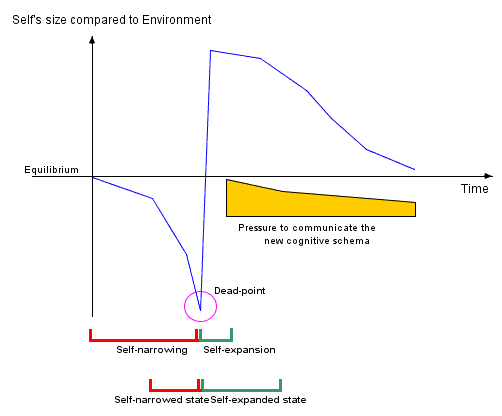- Psychology 2.0
Description of problem-solving using FIPP
< Brains | List of articles related to FIPP | Aggression >
While playing the video press the "HQ" button (in the right bottom corner of the YouTube player) in order to improve playback quality
Fodormik's Integrated Paradigm for Psychology (FIPP)
Miklos Fodor developed a model based on three basic concepts (later highlighted in bold) that can describe human behavior in different fields of life e.g. problem solving, love, religion, sex, co-operation. The essence of the model is that it reinterprets the relationship of the Self and Environment, which to date has been considered as a static relationship. Thus, the model distinguishes
 Self-narrowing: when the Self perceives the Environment as bigger than itself e.g. in anxiety, fear, making efforts, close attention.
Self-narrowing: when the Self perceives the Environment as bigger than itself e.g. in anxiety, fear, making efforts, close attention.
 Self-expanding: when the Self expands into the Environment and perceives it as a part of itself e.g. love, happiness, aha experience, orgasm.
Self-expanding: when the Self expands into the Environment and perceives it as a part of itself e.g. love, happiness, aha experience, orgasm. The change of the two states can be described with a general pattern, in which the turning point is the emergence of new cognitive schemata, being mental constructions organized on different levels, representing the outside world e.g. concepts, theories, shapes, categories.
The emergence of a new cognitive schema results in a need to communicate, which prompts the Self to associate the new schema with others. The Self-expanding is complete only when such communication occurs.
Example: Problem solving
- Self-narrowing: as we learn more about a problem, finding a solution to it seems to be increasingly hopeless.
- Self-expanding: when the person is about to give up, a new cognitive schema establishes itself, which in turn provides a solution to the problem.
- Communicational pressure: regardless of obtaining a solution to the problem, the person does not experience complete Self-expanding until he can share it with others.
A detailed description of the model and of the basic concepts, with further examples, is provided here.
One virtue of this new model is that it integrates our knowledge of human behavior yet does not contradict psychology’s main discoveries. In addition, it harmonizes with statements of world religions and common sense.
On this page... (hide)
1. The role of cognitive schemata in our thinking
Considering that besides Self and Environment, cognitive schemata are important parts of the basic concept of FIPP, the FIPP model is particularly well applicable in describing both the process of thinking and, within that, the process of problem-solving. Cognitive schemata are not merely the building bricks of thinking, but more; they are the leading characters of thinking. Cognitive schemata are not mere building blocks of thinking, but are the lead characters in new thought processes. Thinking is nothing other than the manipulation of the schemata. Considering how many aspects of thinking – e.g. memory, intelligence, creativity – are studied by psychology, this statement seems to oversimplify matters. However, if we examine it more closely:
- we can look at the memory processes as the establishment of a cognitive schema, more precisely the activation of a cognitive schema (cf. Recalling data from the memory);
- we can consider intelligence as choosing and applying the proper schema; or
- creativity can be seen as the establishment of a new cognitive schema by restructuring or combining – or both – those we already have.
I intend not to go into the details of how cognitive schemata work, but rather to focus on our original topic: problem-solving.
2. Problem-solving described with the concepts of FIPP
FIPP attributes every problem to having two or more interfering cognitive schemata, none of which describe the outer world properly, so we cannot choose amongst them. This conflict generates the problem, and is the essence of our problem; the feeling that at root there is a problem, and that we perceive or deal with the situation as a problem.
In order to demonstrate the elegance of the approach, let us imagine the opposite of the situation we described in the former paragraph, namely, a problem to which:
- a cognitive schema is the solution; (‘although I am hungry, there is food in front of me’)
- there are two non-interfering cognitive schemata as a solution: (‘the door is locked; I have a key; and I want to enter’).
What happens in this situation?
- If a certain cognitive schema is the solution, then it describes the reality properly; there is nothing left but to use it and there is then no problem: (‘I begin to eat’).
- If two schemata which fit with each other are needed to describe reality, these two integrate quickly. Again, there is nothing left but to use it. Again, there is no problem here: (‘I open the door with key, then I enter the door’).
2.1 A problem as the interference of cognitive schemata
So, we can accept that a problem is nothing but the conflict of at least two schemata. For the sake of simplicity, let us disregard the possibility of more than two schemata, as the processes are the same.
Hereafter, we can consider the process of problem-solving as the constant growth of the Environment – composed of two interfering cognitive schemata – at the cost of the Self. The growth of the Environment derives from our increasing knowledge of the lower-level schemata which form the basis of the two schemata in discussion, and attempting to match them by breaking them down into increasingly smaller pieces. Different conclusions arise from this process description:
- the process works well if:
- we can identify the schemata
- we identify the constituting schemata properly; and
- we manipulate an increasing number – at increasingly lower levels – of cognitive schemata and to do so we have to suppose that the mind has a processing capacity
To make this clearer, let us examine the two principal results.
The partial schemata: dividing the schema into parts
In order to divide an upper-level schema into its correct parts, we must properly identify its constituent parts. (It is similar to a butcher cutting up a carcass; if he did not know the individual parts of its body, he would end up with strange, literally disjointed, cuts of meat.)
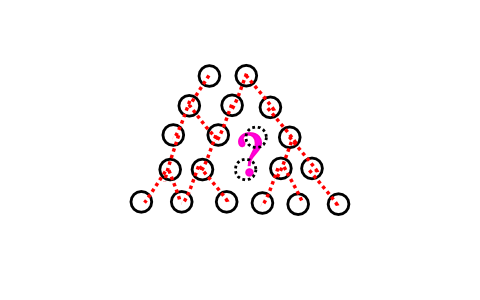
Missing schemata
This phenomenon arises as a schema could also be established in such a way that not all the schemata beneath it are there. (Such is the case of which people make jokes; for example, when someone miscounts 7 x 8, and says that he was absent from school the day they learned it.)
Advertisement
This article, and many others, is now available in print.
The book, 'Self-expansion', contains a generalized version of FIPP not available on psy2.org
The characteristics of the constituent schemata play a leading role when we divide the superior schema into parts. For example, its stability, how accurately it has been checked, how many other schemata it is connected to, and how unambiguous the connections are in themselves and in relation with the other schemata.
This is the difference between schools and schools: accountancy at Harvard is taught just as well as at a fifth-rate college. While the earlier connections have been thoroughly verified, and their unambiguousness have been proven, in the latter there is only surface order, as between the parts there may be contradictions. When a simple accounting exercise has to be undertaken, probably both courses are good enough to provide that capability. However, producing the annual financial report of a major corporation may show dissimilar results.
The other phenomenon when partial schemata come to the surface is teaching. It may mean a serious difficulty for people to explain what it is they do and how. For example, Lance Armstrong (multiple Tour de France winner) http://en.wikipedia.org/wiki/Lance_Armstrong explaining how to steer a bicycle, or what to do with the upper body when somebody is about to fall to the right. In order to convert these movements into words, he has to divide the movements into parts.
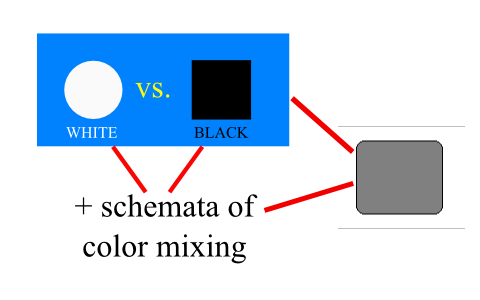
The schemata of color mixing helps solve the conflict between white and black, as it results in gray.
However, it often happens that other schemata help to solve the problem: sometimes it is not possible to integrate two interfering schemata, no matter how much we dissect them, but a third schema can make a threefold connection between them. However, to do this, a third schema has to exist, and somehow (by inserting the other two schemata) all three have to connect. For example, when resolving the opposite of black and white, they are integrated by the schema of color mixing (or rather by the schema of light intensity), as different shades of gray.
The manipulation of partial schemata
Dividing a superior schema into its constituent parts is not enough in itself: we must try to fit them to each other in order to make a new schema. To do that, we have to store the separate sub-schemata and be able to manipulate them. For the moment, let us disregard the speed of manipulation, as this affects intellectual performance. Let us also disregard the strength of the connections amongst the schemata, to which the detachment (the speed of detaching) of the schemata is inversely proportional.
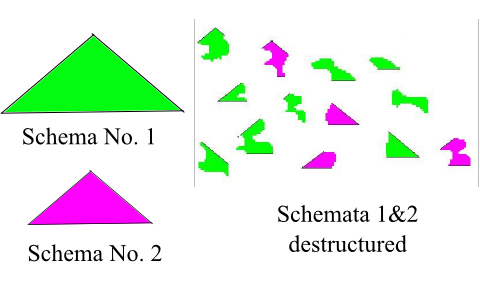
More space is needed to manipulate the sub-schemata
The phenomenon is similar to having two unique puzzles, from certain parts of which a new one can be formed. The size of the surface we work upon can make a difference. (Moreover, it is said that the places where we put things, which is parallel to our thinking strategy in case of schemata – namely how structured our thinking is, or in what order we place the pieces – also makes a difference.)
In this example it is the measure of the working surface, disregarding the number of manageable schemata, which shows a strong connection with solving intellectual problems. In psychology, working memory, or short-term memory, is the relating term. But as mentioned previously, the strategy (the way we structure our schemata, the way we solve problems), speed (how quickly we manipulate the schemata), and the strength of connections (which we have to overcome to divide the schema into parts) all play a serious rôle in a person’s intellectual performance within a certain situation.
2.2 The description of problem-solving
Let us now examine the steps needed to describe problem-solving. The problem can be categorized in two groups:
- when the cognitive schema, meaning the solution, is available to the person
- when the schema, meaning the solution, has to be established
Another possibility is of a problem having no solution, but this fact is unknown to the person.
The non-existent solution
Before concentrating upon problem-solving, let us deal with the non-existent solution. A problem can be unsolvable:
- for a certain person (e.g. for a three-year-old child, 543+675=?);
- if it is excludable according to the rules of logic (e.g. think of a number which is smaller than five but bigger than 7);
- because of the lack of mental resources (e.g. multiply 876231 by 982312 in your head)
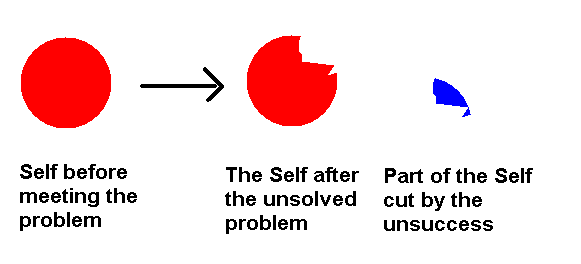
Loosing a part of our Selves due to unsuccess
In case 1, there is a gap of several levels between the existing cognitive schemata and those which are required for the solution. (Staying with the example: the concept of numbers, summation, the concept of digits et al.) In everyday life this may be the most frustrating type of problem (followed by the biggest Self-narrowing), since it can be perceived that the solution exists, only that our schemata are not good enough. If our schemata are inadequate, it means that we cannot model a certain part of the Environment, and are then confronted with the borders of our Selves. This may create a division or reduction of the Self, forcing us to reassess our borders and restructure our Selves. This happens at a much increased rate if it requires an ability we thought we had.
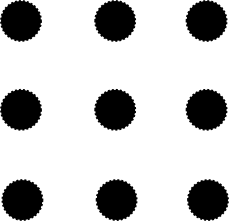
Try to draw a line that passes the 9 points and refracts only 3 times
The second type is not a real problem, as it has a solution: namely, that it is a contradiction in terms, at least within the frameworks we accept it contradicts certain basic statements. In this case, it is rather the uncertainty which troubles us, as it raises the question whether there could be a way to modify the frameworks (technically, paradigms) in such a way that this problem also had a solution. Namely, that everyone has already experienced that new event or feeling which can only be established when we change the paradigm (cf. out-of-the-box-thinking, when one can step out of the frameworks and is able to look on the problem from a higher level, thus bringing new solutions).
However, the third type relates to the question of mental capacity: our memory is not endless, so the number of cognitive schemata we can manipulate at any one time is limited. Everything beyond this limit is unmanageable, or can be managed only very slowly and with different auxiliary techniques; for example, we can use our fingers to solve the above mentioned problem, or imagine it in a written form &c.. If the problem requires far more capacity, that the problem cannot be solved does not cause so much frustration, as the solution is “my brain capacity is unable to allow me to answer”.
2.3 Finding the existing solutions
Finding the existing one
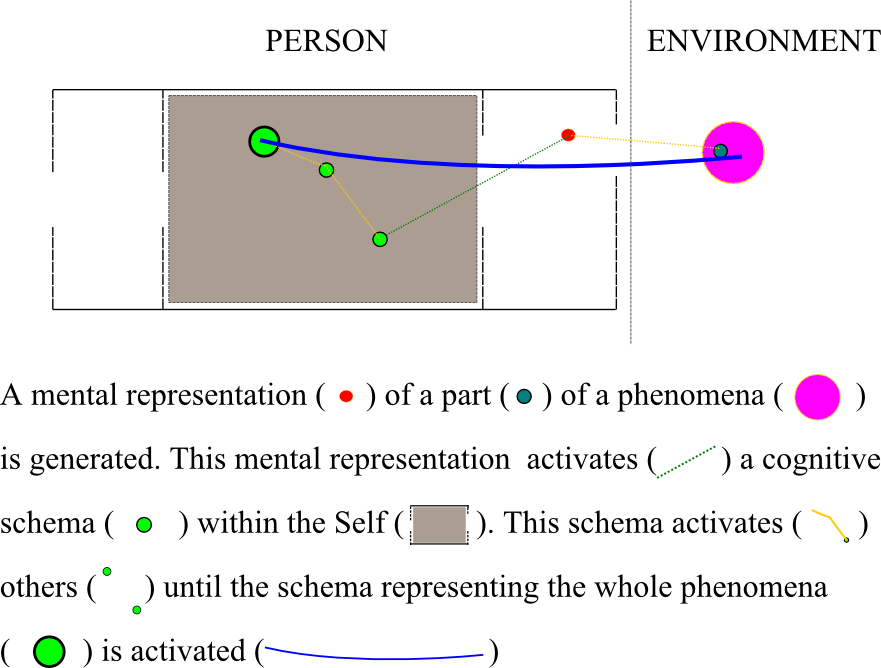
The process of finding an existent solution
The simplest case is when the solution of the problem is readily available. Amongst the person’s cognitive schemata there may be one which properly represents the Environment. The only issue is of recalling this schema. Most often this happens through several metastases: the person identifies a detail of the problem which he can recall, the connecting schemata then activate, which finally (possibly by connecting with other schemata) activates the schema representing the solution of the problem fully and properly.

We recognize an image based on a part of it
For example, when we do not see a whole apple, only a part of it upon which we see the apple’s seeds as well. The seeds activate the schema of the apple’s core, which activate the schema of the apple.
Establishing a new schema
Establishing a new schema is not like drawing on blank paper: no schema can remain still within the Self, as it would then never be activated for lack of a link to it; every new schema should be built on the old/previous ones. This does not mean that an old schemata can not fall into pieces and restructure itself, as it has the parts which preserve the internal relationships of those pieces. These relationships connect the old and new to other pre-existing schemata.
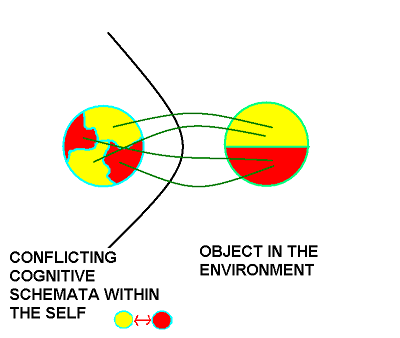
Two conflicting parts within the same object and the activated schemata
As described above, schema fall into pieces, rebuild themselves, and so new schemata are established: certain constituents of the old schemata do not represent the Environment proper, as there is no agreement between the two parts, one or both of them is/are wrong. The same position occurs when two separate schema do not fit each other, despite both of them partially describing the Environment.
Advertisement
This article, and many others, is now available in print.
The book, 'Self-expansion', contains a generalized version of FIPP not available on psy2.org
The Self tries to declare one of the competing ones unusable, and attempts to convince itself that that one is irrelevant on this occasion. If the Self can convince itself to neglect one, it would then be free to use the other competing schema. To achieve this, the Self activates increasingly deeper levels of sub-schemata within the two competing schemata.

Is this a man or a machine?
(For example, on the attached figure the viewer cannot decide whether he sees a man or a machine. It is made of metal, but it has eyes and hands. It has no skin, but its head and extremities are discernible, and so on. This man or machine conflict maintains until he – it – realizes that it is an android. If he could reject the possibility that it is a man, then he would have considered it as a machine, which would then raise the questions of what this machine is for, how it functions &c.)
The more active the sub-schemata beneath the two competing schemata are, the more intense the conflict is and the greater the Self-narrowing. But the connection of the sub-schemata can dissolve just as they are established, and can be reshaped within a new group. These attempts are termed problem-solving. The new schema is established when the partial schemata – by bridging over the differences – may form a new group that integrates everything by different connections within and between the schemata. The establishment of the new schema does not cancel the opposition between the former two schemata (so the concept of the android does not withdraw the man and machine discrimination from use), but integrates them in a new way. The better the integration of the two schemata (the more parts, constituents, partial schemata are integrated), and the more unambiguous it is internally (so there are no opposites between the partial schemata), the more stable and usable it is.
A certain quality assurance is obtained if the brain keeps the number of contradictory connections below an acceptable minimum. As with quality controls in manufacturing, in this case, after a test phase it can be stated that a new product has been made : the new cognitive schema. This also demonstrates that it does not matter if we have an intuition about the right method. We check the principal points before becoming sufficiently happy to share it with our social environment. The main rôle of the social Environment, besides using the new schema, is that it is a part of the testing process: when we tell our friends a new idea or solution, they – with better or worse intentions – will criticize it, so trying to assist us in making an unambiguous cognitive schema.
Testing is nothing other than applying the new schema to different situations, facts &c. As it is nothing other than establishing newer connections with existing schemata, thus it is an increasingly higher level integration to the set of cognitive schemata. Until this testing brings positive results by making more and more positive connections to the cognitive schema (in the mind of the person and the minds of the social Environment), the Self expands more and more. This Self-expansion acts as a positive affirmation (to an optimal level), and the cognitive schema urges the person to further sharing and testing.
Behind the Self-expansion, the more connections the new schema makes, the more often it gives a more valuable answer (more usable, more precise, faster) than previous ones, and so increases the power of the Self over the Environment or, equally, it decreases the Self’s defenselessness in the face of the Environment. This is achieved as, by being able to model it, the Environment can be manipulated or dealt with in a manner that could not be done before.
Self-narrowing is bound to a tendency to do away with one of the two competing schemata in order to be free to use the other; this tendency leads to a certain type of aggression . The aggression is rooted in the mental effort required to disable those connections which activated the cognitive schema, and which is to be ignored; this requires intense concentration. For example, not to think about the possibility that there is a man in the picture above, having decided that we want to see it as a machine. Aggression is also an adequate answer, as until the Self can no longer model the Environment properly it is in danger: since the model is wrong the Environment is less manageable, its reaction or behavior cannot be predicted, and such Environments threaten the existence of the Self. (To expand this example, let us imagine that someone holds a gun to our heads and, if we cannot say what can be seen in the picture of C3PO, shoots us.)
In many cases, the appearance of aggression solves the problem. Think of a tomato that we want to give to someone as a gift, but upon it is an outgrowth, a smaller tomato. By breaking the small tomato off (which in our example is the appearance of aggression) we obtain a perfect tomato and can now give it to the target person.
If we look more closely at the example, we notice a small misinterpretation within it. By breaking the small part off, we obtain a nice tomato. However, the small one will have left a mark upon it. This is the beauty of the example: it shows that aggression does not lead to a perfect solution, as two things were connected, and we removed one of the two competing schema (the small tomato) in vain; the trace of the former link indicates that this is no longer a whole, only a part of the whole. Perhaps expansion of the example is a trifle forced, but maybe the best solution is if we give the juice of both the big and small tomato to the target person, thus preserving the original whole, as in tomato juice the two ingredients do not divide. Of course, the connection between the shape and the content of the tomato has been dissolved again, by squeezing. This is considered to be an aggressive act, as the trace of the missing link will be visible again.
(A small detour: the missing link always indicates that it is not the whole, and that it is in a state preceded by aggression: it is not accidental that people are averse from the sight of a truncated body, even if it is not bloody or the wound is not fresh. The trace of the link – e.g. the site of the missing limb – indicates the preceding aggression and the injury of the whole, thus it cannot activate a whole schema. That is why it can be difficult for us to perceive the injured person as physically whole.)
3. Hunger for problems
The above mentioned connection, according to which Self-expansion has a positive reinforcing effect, has further consequences. Those people for whom problem-solving causes more Self-expansion than Self-narrowing will seek further possibilities for Self-expansion through searching out problems and solving them.
But when does problem-solving in general provide one with more Self-expansion than Self-narrowing? It happens when:
- he can solve the problems he faces because of his abilities
- he faces problems which fit his abilities
- his social Environment is suitable for sharing his newly-established schemata, and thus he gains further Self-expansion.
To make the above list more understandable, let us examine a few examples from the world of children and school:
- Maybe it is easiest to admit that a very intelligent, creative child with a good memory has a greater ability to solve problems than his schoolmates of poorer abilities, as he experiences Self-expansion more often, and will enjoy meeting problems, since he has a bigger chance of solving them than failing and, in doing so, obtain Self-expansion.
- The proper choice of a problem’s level of difficulty can help any child to come to enjoy challenges. Even with lesser abilities, if a teacher give him problems which accord with his intellectual level, knowledge and main abilities – for example, visual creativity, fine motor function (namely manual skills), technical sense, physical abilities &c. – then his sense of competence, and his Self, will grow, and he will with pleasure seek future challenges. The opposite of this is also true. If the child with greater abilities faces overly simple tasks, then the Self-narrowed periods will be short (as he solves the problems easily) And, as a result, the Self-expansion cannot be that important either. So he loses interest in solving problems as a “source of Self-expansion”, and will look for other sources; sport, sex, drugs, gambling etc. That leads his Self through bigger Self-narrowing Self-Expansion phases. We can go further: standards set too high can cause proportionally bigger Self-narrowing even in children with good abilities, which also diverts them from seeking out problems. (This is similar to the phenomenon of “learned helplessness”, when people learn that they cannot change anything in their lives. Their Selves shrink artificially and disproportionately to their abilities, and after a while they give trying to make their lives better. They do not feel that they can affect their Environment, and are always filled with anguish because of their exposure to the Environment.)
- We already know that family background determines a child’s performance in school regardless of their mental abilities. This can be considered more generally. The social Environment with which the child shares his schemata was originally defined as absolutely subjective, so not necessarily the parents or the teacher have to be the important people with whom the child shares his pleasure arising from the new schemata; it could be an old neighbor, or a distant relative. In spite of this, the class, teachers and parents usually offer a determining pattern on sharing knowledge. They provide a atmosphere allowing the child to increase the pleasure which comes from the Self-expansion following problem-solving. The best example of the opposite situation is an unhealthy atmosphere in class, where the lack of knowledge, unpreparedness and foolishness come into play, for example because a child of weak mental ability becomes the central character. Such an atmosphere does not aid problem-solving or sharing it with others. It limits the circle of friends who can function as a social Environment. Moreover, the child cannot have Self-expansion on his own undisturbed, as he will be at a disadvantage if friends catch sight of it. The same applies within the family. The child may discover the parents as partners (so that the parents can function as his social Environment) with whom to share the new schemata he discovered at school. He can tell them, and the parents may even understand what new things he realized in class and further contribute to the child’s ability to both seek problems and to share the joy of the solutions at home.
To summarize… The fortunate concurrence of the above mentioned circumstances, which I consider as a task of the teachers and parents, provides a type of hunger for established problems, which prompts young people to apprehend throughout their lives that part of life which is more difficult, but also provides more pleasure. This hunger for problems is a key issue for, inter alia, successful careers in many fields.
Advertisement
This article, and many others, is now available in print.
The book, 'Self-expansion', contains a generalized version of FIPP not available on psy2.org
4. Self-confidence and artificial self-confidence (narcissism)
As in many cases upon which I have written, the above does not say anything new which we had not known or felt before. The majority of connections I have described are known to people, but maybe a less precise, less unambiguous way. This also applies to the phenomenon of “hunger for problems”.
The majority of parents realize, after evaluating their own – and others – successful careers, that if they want to see their child become a successful person, then that hunger for problems must appear in the child. Many people go further and say that the bigger the hunger for problems, the greater the success the child will achieve. This statement also applies to the first approach. Although a different issue, whatever sacrifice success may require (health, mental balance, human relations &c.), for most of the parents (especially those who were unsuccessful, and are now compensating for this at the cost of their children) no thought is given to this.
In order to proceed, let us accept the following hypothesis as true of parents: “the greater the hunger for problems, the more successful the child”. Note that the assumption incorrectly emphasizes something other than happiness; it is not saying: ”the greater the hunger for problems, the greater the Self-expansion”, which would lead to a happy life.
Unfortunately, parents have the power to artificially intervene and so increase the hunger for problems. How can such interventions be made?
- False feedback: constant compliments – such as how skillful/clever/nice you are – can increase the Self-expansion of the child after successful problem-solving. This may result in a happy child in the short term, and have a reinforcing effect in that the child seeks out new problems and, by solving these, satisfy his and his environment’s need for success
- The child is given seemingly difficult, but actually easy, tasks. In this case he does not obtain greater Self-expansion than he deserves, as the Self-narrowing was not that great. However, the proportions of Self-expansion (after establishing a new cognitive schema) and Self-expansion (after sharing this schema) will be permanently distorted. This creates and builds a strong dependence on social Environment in the long term, as he will expect Self-expansion later in his life, not so much from actual performance, but from social approval, partners, family and friends.
Where does this artificial inflation of the Self, and constant seeking of Self-expansion, eventually lead?
- One possibility previously mentioned is when the performance, due to greater ability, is outstanding, but the hunger for problems can never be satisfied. So, a burden of performance emerges, which relies only on one source of Self-expansion: problem-solving by using the intellect. This disturbs the balance of the personality, that which comes from the possibility to obtain Self-expansion from different sources, such as via human relations, physical activities &c. (cf. Enlightenment section on specialists in a narrow subject with no other interest.)
- It can lead to cheating. When the apparent activity that causes further Self-expansion ends, then the Self-expansion, coming from a disproportionate reflection can only be reached by artificial tools which provide disproportionate effects, for example, through drugs or criminal activity. The problem with these is that they cause substantial Self-expansion only in the short term. In the long term, its negative consequences stand out: e.g. it is good to rob banks, because one will have a lot of money quickly. In the long term, however, he is pursued by police. Constantly hiding from them causes anxiety which leads to Self-narrowing.
- If there is artificial inflation, there can also be eruption. When a person realizes that some people (even with good intentions) lied to him, that is hurtful, especially if these people are close relatives, who by provide the frame of reference in many fields of life. This fracture in somebody’s life causes greater Self-narrowing, although this may still be the least worst scenario compared with the two other alternatives (being a specialist in a narrow subject with no other interest or cheating).
The state of an artificially inflated Self is very difficult to realize. Above all, it is extremely painful to undertake anything against it. No-one is happy about giving up the status he has reached, especially when he is used to fighting for everything and giving up nothing. This lies behind the condition called narcissism. Narcissism (self-love) goes with an overly high level of aspiration, and thus an incapability of achieving happiness, which may cause other mental diseases or problems.
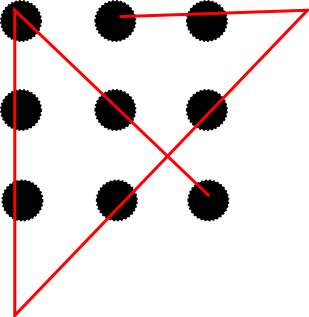
Solution of the 9 points problem
A good example of solving a problem by re-interpreting the frames: nobody said that you are not allowed to leave the imaginary square around the dots...
